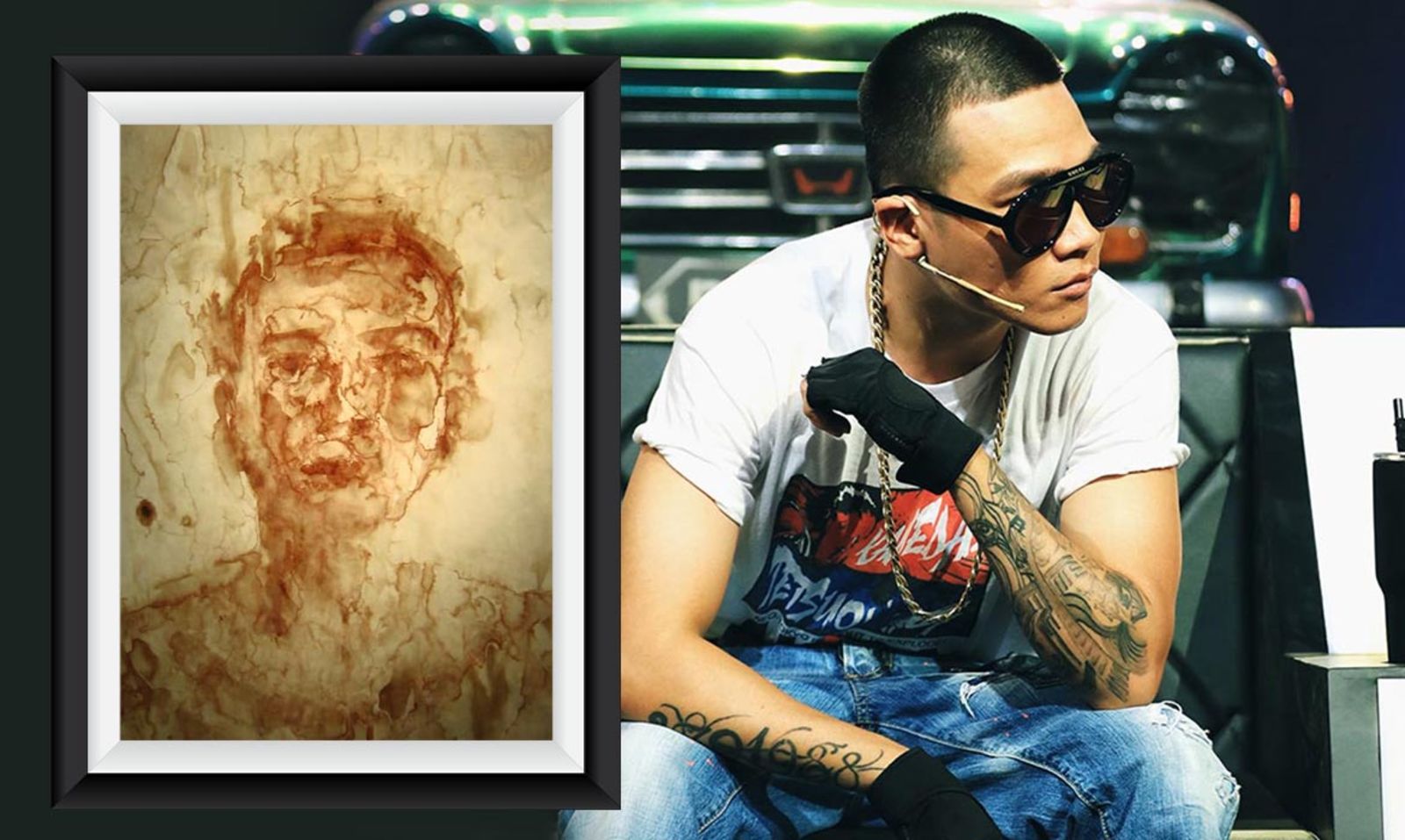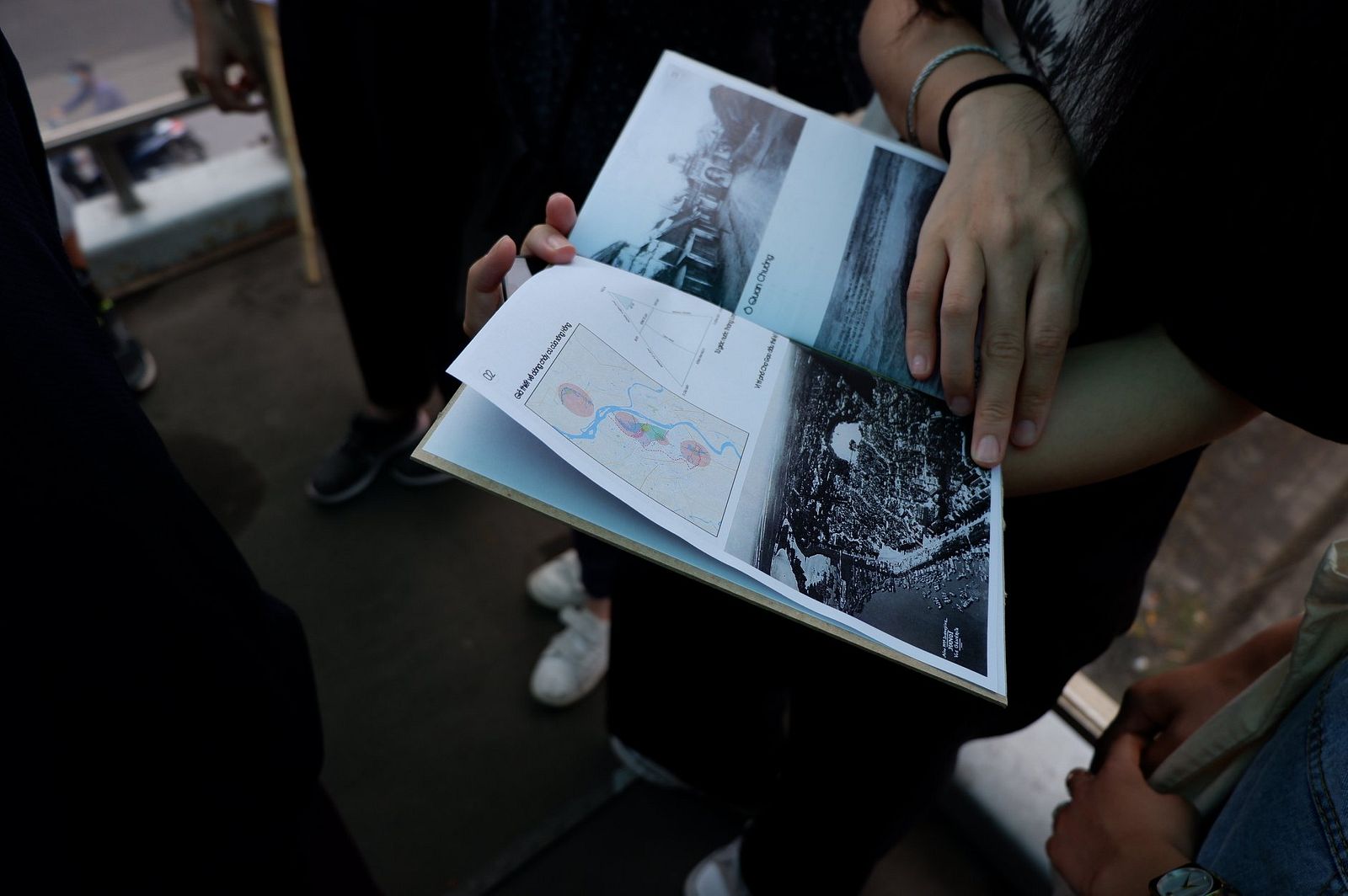Tran Nu YênKhê may be most well-known to Vietnamese audiences because of her unforgettable performances in Tran Anh Hung’s Vietnam Trilogy. However, in recent years, YênKhê has become increasingly established as a contemporary artist. In 2019, her sculpture ‘Borderline’ became the first contemporary artwork from Southeast Asia shown at Paris’s Guimet Museum. Upon returning to Vietnam this year, she continues her artistic journey with the solo exhibition “White Blank” at Galerie Quynh in Saigon from October to December of 2023.

Inside Galerie Quynh where the exhibition is currently on display. Image courtesy of Galerie Quynh.
In the center of the luminous gallery front room stands the large-scale sculpture, ‘IMPERMANENCE,’ Tran Nu YênKhê’s attempt to recreate the complexity of the natural world through masterful use of punctured fiberglass and acrylic. On the pure, undulating white surface, an unbalanced coverage of lighting creates a rhythmic play between the physical work and the dance of light. The room’s walls feature vividly colored paintings on Chinese mulberry paper. Unprimed folds of linen meet the eye. Fluid spreads of whiteness seem deceptively random. Interestingly, a fellow visitor sees animacy, like the wings of a butterfly in its natural habitat in the work. Geometry, however, presents an uncomfortable intrusion. Shut doors floating on linen — a tyrannical and Kubrick-esque presence. A crane scooping up nothingness. A spaceship on its inquiry. An unwelcome centerpiece in your living room.

Tran Nu YênKhê. IMPERMANENCE, 2023, fiberglass, acrylic, 162 x 225 x 99 cm. Image courtesy of Galerie Quynh.

Tran Nu YênKhê. BCD.20, 2023, acrylic, Wenzhou paper, linen, 99 x 139 cm. Image courtesy of Galerie Quynh.
The sharp, sparse honking of Saigon traffic provides a sweet counterpoint to the silent atmosphere inside the top floor of the exhibition room, where I met Tran Nu YênKhê. Our conversation superseded the narrow focus of my interests in the exhibition, and took surprising and pleasant detours into more political topics, YênKhê’s personal family history, and her meditations on how Vietnam and the world has changed through past decades.
While my conversation with the artist reveals how she found inspiration in her COVID-19 pandemic experience and her contemplations on our global ecological crisis, “White Blank” goes beyond concrete representations of the external world. This emphasis on exploring the self is related to the key differences between the process behind the artworks in “White Blank” and her previous exhibition, “Borderline.” While the latter, belonging to a larger structure of Christie’s auction house, aimed to specifically impart messages regarding immigration, geography and modernity, the former is described by YênKhê herself as “a mental process” and “a personal journey.” It deliberately does not try to tell a story or give explicit messages. The goal of avoiding a definitive, singular meaning propelled YênKhê towards abstract art for “White Blank.” Doing so allows her to create her own signification and depart from visual clichés, such as how red often signifies danger. Finding a new mode of signification was the most challenging task for her. And even though Tran Nu YênKhê started her career later than many artists, the reflective journey and retrospection provided by time makes her work urgent and interesting.
“Between Certitude and Doubt” and the pandemic experience
The creation of the series Between Certitude and Doubt, which consists of numbered paintings uniformly titled ‘BCD,’ was an intensely personal process, YênKhê explained. It began during the second year of COVID-19. Finding herself confined to her home, YênKhê delved into the art and theoretical works of artists and thinkers including Matisse, Bacon and Picasso, while reflecting on her own observations of media distrust during the global pandemic. Meanwhile, YênKhê herself had almost irreconcilable conflicts with a family member regarding the pandemic. The two contrasting entities of linen and geometrical blocks; therefore, represent the daunting challenge of conflict resolution: “I wanted to have this conversation in my painting. How can I put two entities [that are] completely opposite, completely different, with different thinking, and different viewpoints in one frame? It’s an attempt.”

Tran Nu YênKhê. BCD.5, 2022, acrylic, Wenzhou paper, linen, 188 x 288 cm. Image courtesy of Galerie Quynh.
The lost feeling that permeates the series is intentional. From the logic of inverse, she makes our eyes work at the same time that we feel disoriented. Taking an abnormal perspective as the central focus, her work makes our eyes question their logic. Vivid colors add to this necessary discomfort that she tries to evoke. The intended effect, she says, is: “You are disturbed, but you do not know what disturbs you.”
This disturbance comes from her fascination with cinema. The geometrical blocks in the ‘BCD’ paintings pay homage to the timeless visuals in Stanley Kubrick's 2001: A Space Odyssey. She recalls being in awe when watching it for the first time and expressed deep admiration for the director’s powerful simplicity and sophisticated visual language: “This kind of film, in a 100 years, it cannot age. It will still have the same impact.” YênKhê humbly admits that her ambition is similarly high, and she is unsure whether or not her goal has been achieved.

Image courtesy of Galerie Quynh.
Equally intriguing is how much the artwork stems from a fascination with architecture from a young age and how her interest was translated into art: “It [geometry or sculpture] is a shelter, it’s home...It’s about the print, the existence of humans in this beautiful nature.”
Parallel to the opposite entities of linen and geometry, the artist expresses hope that humanity will gain a thorough understanding of those with different opinions from them: “If you go back and forth in the room, at one point, they will interact and embrace each other.” This interplay exemplifies YênKhê ’s aspirations for a world in which we can respect differences in others and still maintain a respectful and constructive dialogue. This elaboration from the artist sheds light on what I experience when viewing the paintings for an extended length of time. As the images get a hold of me, I imagine the jarring final images of sci-fi films in which humans evacuate Earth, leaving nothing but ruins and remnants — bricks and wastes. This uncanny feeling led me to bring up themes of technological abundance, ecological crisis and our modern way of living with YênKhê.

Tran Nu YênKhê. BCD.22, 2023, acrylic, Wenzhou paper, linen, 199 x 139 cm. Image courtesy of Galerie Quynh.
“White Blank” sculptures and our ecological crisis
Ecological crisis is an uneasy topic. Some consider it an all-or-nothing type situation while focusing on the gravity of the situation can make taking action difficult. There is also a gap between our knowledge and our willingness to fully commit to environment-friendly practices, while sacrificing a lifestyle filled with consumption and waste production is a challenge. As I brought up these concepts with her, YênKhê provided interesting anecdotes and reflections along with her artistic intentions behind the “White Blank” sculptures — the most overtly ecology-centered series in her art exhibition.

Tran Nu YênKhê. WB.9B, 2023, cast bronze, oil paint, 51.5(h) x 101(w) x 39(d) cm. Image courtesy of Galerie Quynh.
YênKhê’s commitment to environmentalism goes back to her childhood spent in her family’s country house: “From a very young age, I was taught to put my footprint on Earth as little as possible.” She describes her father as avant-garde in terms of thinking about ecology. Instead of having a normal refrigerator, they would dig a big hole in the garden and build a natural fridge. YênKhê looks back on the experience fondly and notes that everything afterward for her is related to ecology and taking care of nature.
Returning to the theme of conflict, she points out that for nature to reap benefits, we must be willing to sacrifice some of our comfort. And this provides a segue into her reflections on the “White Blank” series. She describes her vision of coral in the sea bleeding and dying as a means to contemplate the disappearing and dying nature. Plaster — a material that she repeatedly describes as “humble” and readily available — is employed to communicate the theme of recovery. Although the idea of using plaster was not something that YênKhê came up with in the beginning, it worked effectively as a means for her confrontation with a deteriorating nature. As the sculpture is larger than she is, she recalls having to “dance with the sculpture”: “I needed to hold it for more than half an hour so that it [the plaster] becomes more rigid.”
Due to the thinness of the paper, retouching was not an option. YênKhê describes the process as “one trace, one unique gesture.” For her, the patience and technique required rivals the practice of calligraphy. The white-painted bronze is simultaneously an homage to Picasso and an allusion to the very first use of bronze in Mesopotamia. YênKhê describes the sculptures in this exhibition as “a second way to work with the grammar of bronze” that alters the more common impression of bronze as simply “even and shiny.”

Tran Nu YênKhê. WB.6, 2022, plaster, wire, 39(h) x 76(w) x 48(d)cm. Image courtesy of Galerie Quynh.
In her final remarks, YênKhê expresses her happiness with the observation that young people have paid great care to issues of sustainability and taken measures to take care of the environment. She juxtaposes the youth’s efforts with the precariousness of her own generation, who “destroyed the planet.” However, she also notices how much we are becoming over-reliant on the aid of technology, reflecting on her memory of visitors in Rome and her own exhibition. Attention, for her, must not only be paid to the people surrounding us, the nature around us, but also inward: “In this exhibition, I want you to look at your inner side. People know a lot about machines, this and that, but not how things are working within them. Few people know how kidneys and livers work.”
Her observation evokes the idea that our body is an ecosystem in and of itself, and it’s in the same precarious situation as nature. This emphasis on regaining intimacy with our own bodies and consciousness strikes a parallel with the physicality of the materials — linen, plaster, paper, and bronze, calling attention to a sensuous immediacy that commands us to question our convictions and banality, all while surrendering to our perceptions.
“White Blank” by Tran Nu YênKhê will be on display at Galerie Quynh, 118 Nguyễn Văn Thủ, Dakao Ward, D1, HCMC until December 30, 2023. For more information about the event, visit the gallery's Facebook page here.















